|
|
|||
THIS WEEK at HILTON POND
15-21 August 2006
Installment #325---Visitor #
(Back to Preceding Week; on to Next Week)
|
A MIDSUMMER NIGHT'S
(SPIDER) DREAM True to form for an old farmhouse in the Carolina Piedmont, the structure that serves Hilton Pond Center as residence and office has a white exterior. It's likely early settlers in this part of the country painted their dwellings white to reflect harsh rays of summer sun, so we trusted the wisdom of our predecessors and retained that color when we bought the house and property in 1982. Several years later, we elected to install vinyl siding--still white, of course--to eliminate the need to strip and re-paint the house as the finish inevitably weathered, cracked, and peeled. We weren't aware that because of the way it is installed, vinyl siding creates a multitude of cracks and crannies that become perfect hiding places for platoons of spiders.
These days, at the peak of the warm season, literally thousands of spiderwebs adorn the farmhouse exterior--ample proof our local arachnid population has grown exponentially in the past 25 years. Much of this increase seems to be due to convolutions in the siding, but we also suspect someone may be sending a newsletter out to spiders everywhere,
All text & photos © Hilton Pond Center First off we must divulge that taking pictures of spiders at night was no easy task. Some arachnids--with their eight beady little eyes--shied away from the beam of the flashlight we used to find them in their webs. Second, although the night is usually still, there's often just enough breeze to move a web back and forth like a sail, making it very difficult to keep the spider in focus. And then there are always pesky little moths and other insects flying into the web, causing quite a ruckus as the spider comes out at breakneck speed to attack, bite, and paralyze its prey before wrapping it up like a little silken mummy. Despite these impediments, we were able to get a few shots of our local nightime arachnid population and present the gallery herein.
Among the largest of our many nocturnal spiders are the orbweavers, so called because their webs usually consist of what appear to be increasingly larger concentric circles (as in part of the six-inch diameter web above, spun by subadult quarter-inch orbweaver). These "circles" are actually just a single strand of adhesive silk laid down in an ever-widening spiral that starts near web center and ends at its perimeter. The spiral is placed on straight strands of non-sticky silk that radiate like spokes of a wheel. Typically the orbweaver hangs head down at the center of the web with tips of its eight legs touching several radial lines. As a prey item hits and is ensnared by the sticky part of the web, vibrations travel along silken strands to alert the spider, which quickly goes out on its next pantry-filling, mummy-making mission.
The spiders in the three photos above are all in the Orbweaver Family (Araneidae). The topmost spider--the one that's nearly all-brown and without prominent leg banding--is an old female Redfemured Spotted Orbweaver, Neoscona domiciliorum that shows how "hairy" an orbweaver's body can be. Such "hairs," which are actually bristly protrusions of the spider exoskeleton, occur on its abdomen, cephalothorax (fused head and thorax regions), and legs. These structures probably give the spider more sensitivity to touch stimuli and also may make it a little less palatable to smaller predators. The orbweaver just above is similarly hairy but has leg banding and abdominal markings; it's a young male Redfemured Spotted Orbweaver. Of special interest in this photo are the spider's two largest eyes that glow in the light of the camera flash, and its two large specialized mouthparts called pedipalps; these structures help manipulate food and, in males, are uniquely structured and function in copulation. The pedipals in the male just above are paddle-shaped.
Some spiders don't just hang abdomen-up like the orbweavers--they hang COMPLETELY upside down, as in these photos of a female Common House Spider, Achaearanea tepidariorum (above), and the unidentified arachnid below. In these species, the web can be a nearly flat, table-like structure with or without a criss-crossing network of single strands strung above it. When a prey item hits one of these strands, it typically becomes disoriented and falls to the flat web below, where the spider bites and kills it through the silk.
Still other spiders build a web that's a horizontal platform or tube-like structure on which the spider can sit motionless or patrol back and forth like the male Funnel-Web Grass Spider, Agelenopsis naevia (below). When a prey item falls onto the platform, the spider rushes out and grabs the prey with forelegs while stabbing it with poison fangs.
At first glance it may appear there are two spiders in our final photo above, but there's just one; the upper image is merely the shadow of the actual Funnel-Web Grass Spider, lit from below by a flashlight. The shadowy male spider shows off prominent pedipalps, while the real one reveals two elongated spinnerets at the rear of its abdomen. As their name implies, these structures produce and manipulate the strands of fine silk that are spun into webs--webs that this week adorn nearly every square inch of vinyl siding on our old farmhouse at Hilton Pond Center, providing plenty of midsummer's night photo opportunities when we should have been dreaming instead of firing off our camera in the dark. All text & photos © Hilton Pond Center POSTSCRIPT: A comprehensive photo field guide for all Southeastern spiders isn't available, and it's difficult to key out a live spider. Nonetheless, Spiders of the Eastern United States: A Photographic Guide by Samford University biology profs Mike Howell & Ron Jenkins is very useful for family identification. Thanks to Mike for verifying identifications of the spiders above. Comments or questions about this week's installment?
Thanks to the following fine folks for recent gifts in support of Hilton Pond Center for Piedmont Natural History and/or Operation RubyThroat: The Hummingbird Project. Your contributions allow us to continue writing, photographing, and sharing "This Week at Hilton Pond." (See Support if you'd like to make a gift of your own.)
"This Week at Hilton Pond" is written & photographed You may wish to consult our Index of all nature topics covered since February 2000. You can also use our on-line Hilton Pond Search Engine at the bottom of this page. For a free, non-fattening, on-line subscription to |

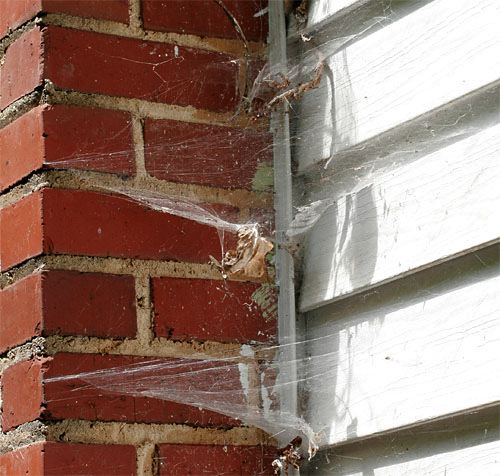
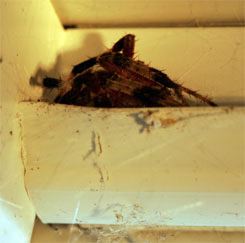 inviting them to move to Hilton Pond where they can live and breed without danger from chemical pesticides other homeowners might use. By day our plentiful webs glisten in the sunlight, catching falling leaves and other windblown debris (above), but spiders that spun them--in this case, Funnel-Web Grass Spiders--are nowhere to be seen; they and countless other arachnids are all all huddled away in those little siding gaps where we can't get decent photos (right). This week, however, under duress from insomnia brought on by a recent back injury, we were up most of several nights anyway, so we got out our digital SLR with macro lens and flash, mounted the camera on a tripod, and spent a midsummer's night not dreaming about but photographing an assortment of spiders on the farmhouse siding at Hilton Pond Center.
inviting them to move to Hilton Pond where they can live and breed without danger from chemical pesticides other homeowners might use. By day our plentiful webs glisten in the sunlight, catching falling leaves and other windblown debris (above), but spiders that spun them--in this case, Funnel-Web Grass Spiders--are nowhere to be seen; they and countless other arachnids are all all huddled away in those little siding gaps where we can't get decent photos (right). This week, however, under duress from insomnia brought on by a recent back injury, we were up most of several nights anyway, so we got out our digital SLR with macro lens and flash, mounted the camera on a tripod, and spent a midsummer's night not dreaming about but photographing an assortment of spiders on the farmhouse siding at Hilton Pond Center.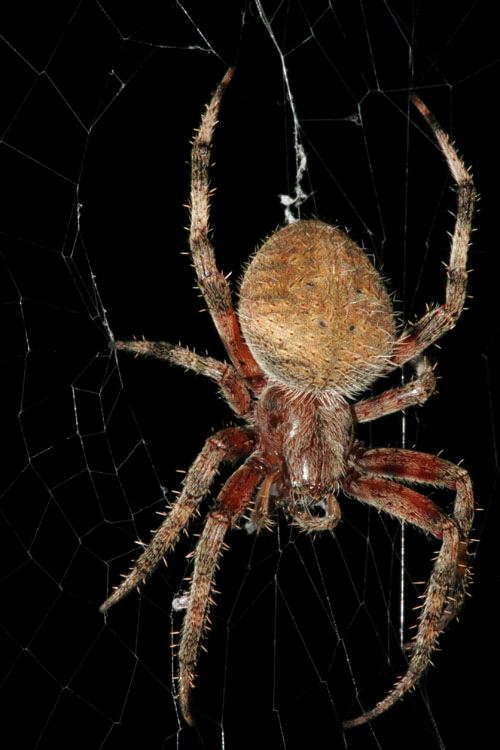
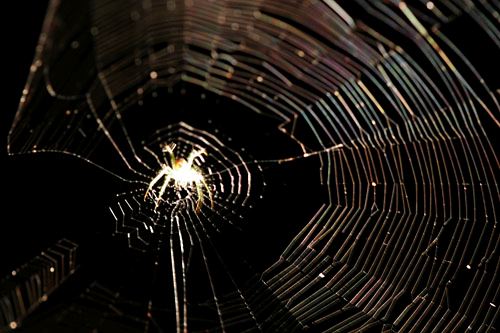
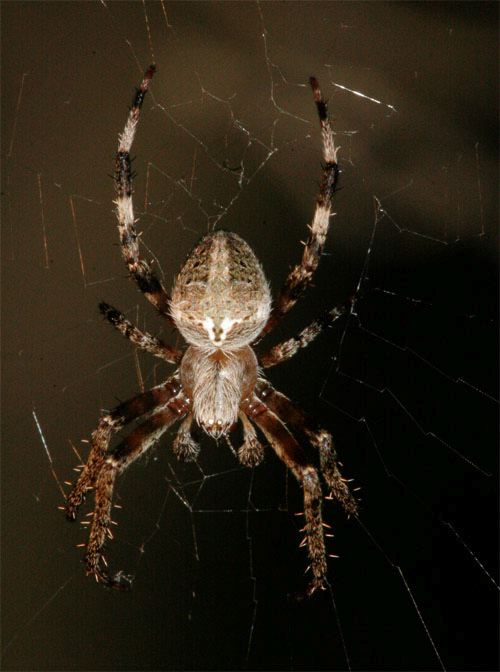
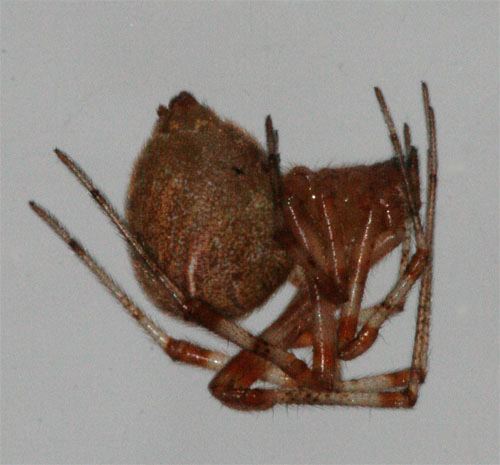
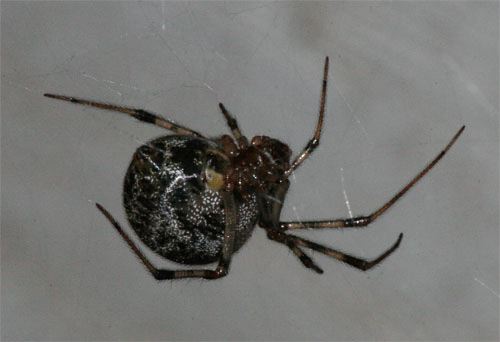
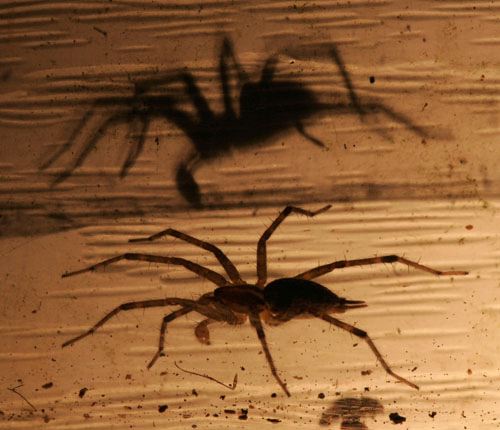


 Please report your
Please report your
